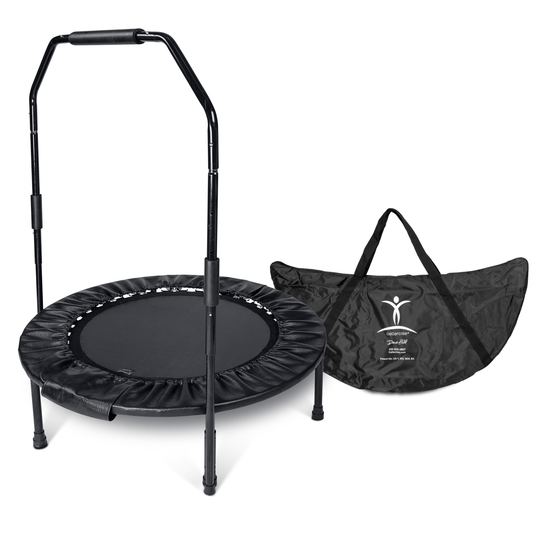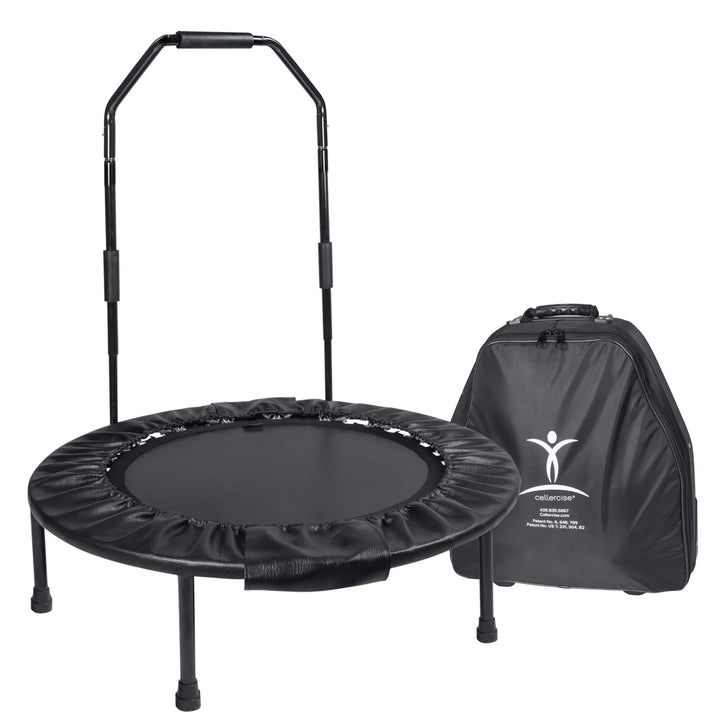Disclaimer: This Blog/Web Site is made available by the publisher for educational purposes only as well as to give general information & understanding regarding the industry. It is not to be used as specific medical advice or to replace consulting with your doctor. You should always consult with your doctor. By using this Blog / Web Site you understand that this Blog/Web Site should not be used as a substitute for medical advice from a licensed professional. For our full disclaimer, please read: Cellercise® Disclaimer
Rebounding exercise has many health benefits, but it’s important to do it safely. Because rebounding exercise involves bouncing on a raised surface, there is a chance you may fall or put too much strain on yourself. Following proper safety procedures when rebounding lets you make the most of your workout routine.
Buy a Quality Rebounder
The first step for a safe rebounding routine is to make sure you have a quality rebounder. Your trampoline is going to be your primary source of support; you need to be sure it can hold your weight and not break from the strain of your workout. With a low-quality rebounder, you run the risk of having it break, causing you to crash to the ground and sustain potentially serious injuries. The major components of a mini-trampoline are the mat, the springs, and the frame. You should make sure the mat has proper stitching, the springs are long enough to give you the proper amount of bounce, and the frame should hold sturdily when in use. Even one lower-quality component could cause a problem. You shouldn’t select a trampoline that is so cheap that it’s likely to break while in use.
Be Aware of Pelvic Floor Risk Factors
Rebounding may not be as high-impact an exercise as trampoline routines are, but it can still cause pelvic floor injuries if not done correctly. Women with previous pelvic floor problems such as symptomatic prolapse and pelvic pain may need to avoid rebounding exercises or adjust their workouts accordingly. Other pelvic floor risk factors include: Childbirth history Body weight Chronic straining Pelvic floor tissue laxity History of pelvic floor surgery If you have these risk factors and still choose to do rebounding, you should avoid double leg impact-style landings, try to keep one foot on the rebounder while exercising, and avoid using hand weights when rebounding. Like any other exercise routine, it is best to check with your doctor before starting rebounding to make sure you are not worsening any risk factors.
Proper Assembly
Just as you need a quality rebounder to have a safe workout routine, you also need to make sure you assemble your rebounder properly. Read all included instructions before starting the assembly process and follow all steps to ensure that your rebounder will support your exercise routine.
Choose an Appropriate Rebounding Area
Rebounders are an indoor exercise tool, but that does not mean you can set them up anywhere without risks. You need to make sure there is enough space for you to bounce safely. This includes vertical and horizontal space so that you don't run the risk of hitting your head on the ceiling or any nearby obstacles as you jump. Also, make sure that the area immediately around the rebounder is free of obstructions. Even if you don't have anything you could hit while jumping, there's a chance you may slip or land incorrectly. Anything scattered on the floor can become a hazard, causing you to further lose your balance upon hitting the floor or even puncturing the skin when you land. Maintain proper airflow in your rebounding space by opening windows or doors. If you do choose to rebound outside, make sure the rebounder is not wet before use and take precautions to avoid trees and dangerous ground obstacles. Never place the rebounder on an elevated surface and make sure the ground underneath is flat and even.
Check Rebounder Before Exercising
Just as important as the initial assembly is keeping up with proper maintenance. While rebounders don’t have too many parts that go bad quickly, you should always check for any worn or missing pieces before you begin exercising and replace them when necessary. Some rebounders have screw on legs, so you should make sure they are firmly connected to the rest of the trampoline.
Supervise Children
Rebounding is just as beneficial for children as it is for adults, and it's likely to be a fun form of exercise for them. Always closely supervise a child if it is their first time on a rebounder and watch them during any following uses. Make sure children understand that a rebounder can only support one person at a time and that they need to take turns.
Proper Clothing
Slipping is a potential risk of rebounding, so make sure your feet do not slide on the rebounder. Dave Hall, owner of Cellercise® highly recommends barefoot rebounding, for safety and maximum flexibility. Only wear clothing that is not loose or long enough to catch in the rebounder springs while exercising. There’s no sense in exercising if your routine raises the risk of hurting yourself.
NOTE: Remember to always consult with your doctor or health professional before starting new exercise routines.
Get Your Cellerciser® and start rebounding today!














